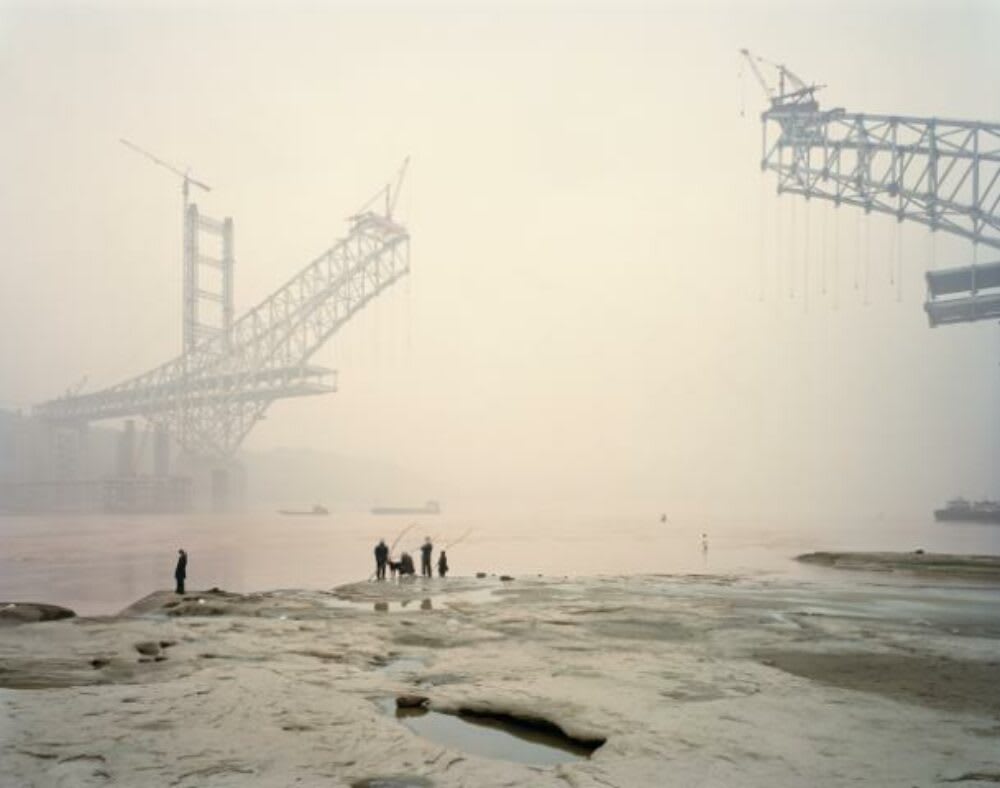Landmark exhibition reviewed in One Stop Arts Blog
"Landmark: Fields of Photography is the second collaboration between the Positive View Foundation (an organisation which promotes the visual arts and brings photography to disadvantaged young people), and curator William A. Ewing, following his very successful recent exhibition Henri Cartier-Bresson: A Question of Colour.This is a major new exhibition, with contributions from many photographers of international renown. Its aim is to challenge our perceptions of landscape (and landscape photography), and to add to its traditional definition, whilst maintaining the power that landscape art has over its viewer.
"Landscape" entered the English language at the start of the 17th century, coming from the Dutchlandschap, which originally meant "a patch of cultivated ground" before it came to mean "image". It is no surprise, then, that thinking of the word conjures up lush, verdant pastures, dreamy cloudscapes, beautiful vistas from atop mountains, and so on. The point that Ewing makes in this exhibition is that this idea of landscapes is artificially restrictive and romanticised, especially in this day and age: it is not all a bucolic idyll. Through over 130 striking photographs, the exhibition presents a geographical survey that provides a radical redefinition of landscapes for the modern world.
The photographs themselves are all outstanding works of art, though their subjects are not always pleasant. Daniel Beltrá's bird's-eye view of the notorious Gulf of Mexico oil spill of 2010 ironically makes one of the worst ever environmental disasters look beautiful, its azure-blue waters and inky-black plumes of oil contrasting with the orange wave crests, whilst Edward Burtynsky'sNickel Tailingsseries presents very simply composed photographs of bright orange rivers of waste from nickel mining against the black earth through which they flow - gorgeous, but environmentally disastrous. There are photographs of colourful but dilapidated Indian slums, of China's rapidly advancing infrastructure projects, and of large-scale American industrialisation, all of which have a certain '"wow" factor, but without romanticising their content. Conversely, a coastal photograph by John Davies, taken in 2004, sits next to a 1983 photograph of the same patch, when it was the site of the Easington colliery; the colliery isn't exactly pretty, but there's something uneasy about the "natural" landscape in the former photograph.
Of course, there are some photographs in this exhibition which have a genuine impact, without the viewer then having that "hang on..." moment, when they realise what the photograph is really showing. But, without fail, each of the more traditional landscape photographs has something new to add to the genre. Olaf Otto Becker's soft-focus photographs of the Ilulissat Icefjord have a convincing, painterly quality about them, but they are honest in a way that many landscape paintings are not: they show exactly what is there. There is Simon Roberts'sSouth Downs Way, which shows a view of the fields below the chalk hills, but with miniscule dots attached to colourful parachutes descending away from the camera. Then there is the undulating landscape of the rocky, fertile land on which a golf resort has almost imperceptibly been built (Michael Light'sWolf Creek Golf Resort).
There is plenty in this exhibition for fans of conceptual art, too. The exhibition itself is sub-divided into themed "fields" such asDelusion, Scar, Hallucination,andControl, which provides a completely novel way of classifying landscape art. John Stezaker (of Deutsche Börse Photography Prize-winning fame) humorously creates collages of country scenes over wrinkled human faces, such that one seamlessly blends into the other. Landscape in all its artificial glory is exemplified by Reiner Riedler'sWild River, Florida, showing carefully-placed rocky greenery beside a river down which holiday-makers float in giant rubber rings. Challenging the concept of landscape even more deeply are photographers such as Susan Evans, who presents a featureless panorama, onto which words such as "tree", "ripple" and "mist" are placed exactly over the places one would expect to find the objects themselve. Olaf Breining's laugh-out-loudComplaining Foresttakes a fairly dull photograph of bare trees and adds words such as "ooh!", "brrr" and "ouch!", lending the trees a human quality (well, if we had to stand still in the freezing cold all the time...).
My only gripe was that there were no explanations accompanying the photographs, but I suppose that would have distracted the viewer and reduced the power of the pictures on display. But Landmarkis a very clever exhibition, and there is plenty for everyone. Those who like to look at aesthetically pleasing photographs are very well catered for, whilst those craving a deeper meaning from photographs will also be pleasantly satisfied. From a technical point of view, myriad photographic techniques and production methods are evident. It is a truly remarkable exhibition, of a quality that one would expect from major galleries and museums."
Julia Savage
